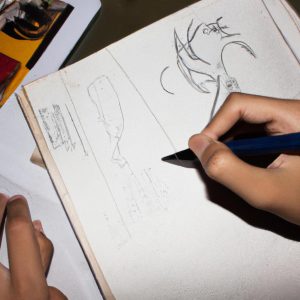Drawing Techniques: Art and Comics: Creative Loans

Drawing techniques are an integral part of the artistic world, serving as a means of creative expression and communication. From traditional art forms to contemporary comics, these techniques play a significant role in captivating audiences and conveying messages effectively. This article explores the intersection between drawing techniques, art, and comics, focusing specifically on how artists borrow from one another to enhance their own creations.
To illustrate this concept further, let us consider a hypothetical scenario: A young artist named Alex is deeply inspired by the works of renowned comic book illustrator Jamie Hewlett. Relishing in Hewlett’s distinct style and technique, Alex seeks to incorporate similar elements into their own artwork. By carefully studying Hewlett’s drawings and understanding his use of line work, shading, and composition, Alex learns various drawing techniques that enable them to create visually engaging characters and narratives within their own comic panels.
In examining such instances of borrowing or “creative loans” among artists, it becomes evident that drawing techniques serve as both tools for individual growth and bridges for collective inspiration. Through exploring different styles and approaches found in art and comics, artists can expand their repertoire of skills while contributing to the evolution of these visual mediums. In the following sections, we will delve deeper into specific examples where drawing techniques have been borrowed across disciplines to create innovative and compelling artworks.
One notable example is the influence of traditional Japanese manga on Western comic book art. Manga, with its distinctive linework, exaggerated expressions, and dynamic panel layouts, has had a significant impact on comic artists worldwide. Artists like Bryan Lee O’Malley (creator of “Scott Pilgrim”) and Becky Cloonan (known for her work on “Gotham Academy”) have incorporated elements of manga into their illustrations, infusing their own unique styles with the energy and storytelling techniques found in Japanese comics.
Another instance of borrowing drawing techniques can be seen in the world of animation. Animators often draw inspiration from various sources to bring their characters to life. For instance, Disney animators looked to classical art techniques and anatomy studies to create realistic movements and expressions in their iconic hand-drawn films. Similarly, modern animators often take cues from comic book artists to capture the dynamism and exaggeration necessary for animated action sequences.
Furthermore, the advent of digital tools has revolutionized drawing techniques in recent years. Many traditional artists have embraced digital platforms as a means to enhance their artwork. By utilizing software like Adobe Photoshop or Procreate, artists can experiment with different brushes, textures, and layers that mimic traditional media but offer greater flexibility and ease of editing. This merging of traditional and digital techniques has led to exciting new possibilities for creating visually stunning illustrations across various mediums.
In conclusion, drawing techniques serve as a bridge between different artistic disciplines, enabling artists to borrow ideas from one another while adding their own unique stamp. Whether it’s through incorporating manga-inspired linework into Western comics or using classical art principles in animation, these creative loans contribute to the evolution and growth of visual storytelling. By embracing these influences and exploring different approaches found in art and comics, artists can push boundaries and create captivating works that resonate with audiences worldwide.
Understanding the importance of drawing techniques
Understanding the Importance of Drawing Techniques
Drawing is a fundamental skill in art and comics, serving as the foundation for creating visually engaging and expressive works. Mastery of drawing techniques not only enhances an artist’s ability to bring their creative ideas to life but also plays a crucial role in effectively communicating emotions, narratives, and concepts to the audience. To illustrate this point, consider the case of Sarah, a budding comic artist who struggled with her character designs until she dedicated time to studying different drawing techniques. Through practice and exploration, she was able to refine her skills and create captivating characters that resonated with readers.
To comprehend the significance of drawing techniques, it is essential to recognize how they contribute to an artist’s ability to convey specific visual elements effectively. These can range from basic principles such as line quality and shading techniques to more advanced concepts like perspective and composition. By employing various drawing techniques strategically, artists are able to manipulate these elements to evoke specific emotional responses from viewers. For example:
- The use of bold outlines coupled with dynamic linework can convey energy and movement.
- Skillful manipulation of light and shadow creates depth and adds realism or drama.
- Attention to proportion and anatomy enables artists to accurately depict human figures or creatures.
- Understanding color theory allows for effective use of hues that enhance mood or symbolism.
In addition to evoking emotional responses through technical proficiency, mastering drawing techniques empowers artists by expanding their creative possibilities. By developing a diverse set of skills, artists gain versatility in exploring different art styles within their work. This adaptability allows them to tailor their drawings’ aesthetics based on the unique requirements of each project or personal preference.
By recognizing the importance of drawing techniques in conveying emotions, enhancing communication, and enabling artistic flexibility, aspiring artists can appreciate why investing time into learning and refining these skills is crucial for growth. In the subsequent section about “Exploring various art styles in drawing,” we will delve into how understanding drawing techniques opens up opportunities to experiment with different artistic approaches, ultimately expanding an artist’s creative repertoire.
Exploring various art styles in drawing
Understanding the importance of drawing techniques is crucial for artists and comic creators alike. By mastering various techniques, they can effectively convey their ideas and bring their artwork to life. In this section, we will explore different art styles commonly employed in drawing.
One example of an art style that utilizes specific drawing techniques is hyperrealism. Hyperrealistic drawings aim to replicate reality with astonishing precision, often blurring the line between a photograph and a hand-drawn image. Artists who specialize in hyperrealism pay close attention to detail, using meticulous shading and highlighting techniques to create depth and texture.
To further delve into the world of art styles, let us consider some common drawing techniques utilized by artists across different genres:
- Cross-hatching: This technique involves creating a series of intersecting lines to add shading and texture to an illustration.
- Stippling: Here, small dots are used to build up tones and textures within a drawing, resulting in intricate patterns.
- Contouring: This method emphasizes the outline and form of objects or figures through bold lines, capturing their essence.
- Smudging: Artists use smudging tools like tortillons or blending stumps to blend graphite or charcoal marks together smoothly.
To illustrate how these techniques can evoke emotions in viewers, let’s examine a table depicting four distinct artworks created using different approaches:
| Artwork | Technique Used | Emotional Response |
|---|---|---|
| A | Cross-hatching | Eerie |
| B | Stippling | Intriguing |
| C | Contouring | Dynamic |
| D | Smudging | Soft |
As one delves into each unique artwork employing its respective technique, an emotional response emerges from the viewer – be it fascination at the fine details achieved through cross-hatching or captivation by the intricate patterns formed via stippling.
By understanding various art styles and techniques, artists can expand their creative repertoire. This skill plays a fundamental role in creating depth and dimension within artworks, allowing them to come alive on paper.
Mastering the use of shading and highlights
Transitioning from the previous section, where we delved into understanding different art styles in drawing, let us now shift our focus to mastering the use of shading and highlights. By effectively utilizing these techniques, artists can add depth and dimensionality to their drawings, bringing them to life.
To grasp the importance of shading and highlights, let’s consider a hypothetical scenario involving an artist named Alex. In one of Alex’s drawings, they depicted a landscape with mountains in the background. However, without proper shading and highlighting techniques, the mountains appear flat and lack definition. By implementing shading and highlighting appropriately, like adding darker tones on one side of each mountain peak to create shadows while using lighter tones on the opposite sides to simulate light reflection, Alex could transform this artwork into a visually captivating piece.
In order to master shading and highlights effectively, here are some key points for consideration:
- Understand light sources: Identify the primary light source in your composition as it will determine where shadows fall and how highlights should be placed.
- Study value scales: Familiarize yourself with different values ranging from dark to light and practice creating smooth transitions between them.
- Experiment with materials: Explore various drawing tools such as pencils or charcoal that allow you to achieve different shades easily.
- Observe real-life examples: Pay attention to how light interacts with objects in your surroundings; study photographs or observe nature closely for inspiration.
- Shading techniques bring depth and realism to artwork
- Highlights accentuate focal points in a drawing
- Properly executed shading creates contrast within a composition
- Skillful use of highlights adds sparkle and luminosity to a piece
Additionally, we can illustrate these ideas further by incorporating a table:
| Shading Techniques | Highlighting Methods | Benefits |
|---|---|---|
| Cross-hatching | Spotlights and reflections | Enhances three-dimensionality |
| Stippling | Smudging | Adds visual interest |
| Contouring | Blending | Creates focal points |
By implementing shading and highlighting techniques effectively, artists can elevate their drawings by adding depth, dimensionality, and a sense of realism. This paves the way for our next section on utilizing perspective in drawings, where we will explore how to create an illusion of space and depth within two-dimensional artworks.
Utilizing perspective in drawings
Transitioning from the previous section on mastering shading and highlights, artists can further enhance their drawings by incorporating texture. By adding different textures to their artwork, artists can create a sense of depth and realism that captivates viewers. For example, imagine an artist drawing a landscape scene featuring a dense forest. By skillfully applying various textural elements such as rough tree bark, soft grass, and smooth water surfaces, the artist can evoke a multisensory experience for the observer.
To effectively incorporate texture into drawings, consider the following techniques:
-
Experiment with Different Mark-Making Tools:
- Use pencils with varying lead hardness or charcoal sticks to achieve diverse textures.
- Explore alternative tools like sponges, cotton swabs, or even unconventional items such as toothbrushes to add unique textures.
-
Observe Real-Life Textures:
- Study objects in your surroundings and pay attention to their tactile qualities.
- Analyze how light interacts differently with each surface and replicate those effects in your drawings.
-
Utilize Cross-Hatching Techniques:
- Employ cross-hatching—the method of intersecting parallel lines—to mimic textures like fabric or wood grain.
- Adjust the density of hatched lines to convey different levels of texture intensity.
-
Consider Mixed Media Approaches:
- Combine traditional drawing materials with other mediums like collage or digital overlays to introduce additional dimensions of texture.
Table: Examples of Textural Elements
| Texture | Description | Example |
|---|---|---|
| Rough | Coarse surface characterized by prominent irregularities | Tree bark |
| Smooth | Even and polished surface without any noticeable irregularities | Glass |
| Soft | Delicate and yielding surface | Flower petals |
| Grainy | Surface composed of small particles | Sandpaper |
By incorporating texture, artists can bring their drawings to life, making them more visually engaging and immersive. The use of various mark-making tools, observing real-life textures, employing cross-hatching techniques, and experimenting with mixed media approaches are all effective methods for achieving compelling textural effects. In the following section on creating dynamic and expressive character designs, we will explore how adding texture can play a vital role in enhancing the overall impact of characters’ appearances.
Building upon the concept of texture, let’s now delve into the realm of creating dynamic and expressive character designs without compromising artistic integrity.
Creating dynamic and expressive character designs
Building on the foundational knowledge of utilizing perspective in drawings, we now turn our attention to creating dynamic and expressive character designs. By employing various techniques and principles, artists can breathe life into their characters, capturing their personalities and emotions with precision.
Character design is a crucial aspect of both art and comics as it sets the tone for storytelling and engages viewers on an emotional level. Consider the case of Lisa, a comic artist aiming to create a captivating superhero character. To achieve this, she focuses on incorporating elements that convey strength, vulnerability, and relatability. This approach allows her audience to connect deeply with the character’s journey.
To effectively create dynamic and expressive character designs, artists should consider the following:
- Anatomy: Understanding human anatomy is essential when designing characters. Artists must be knowledgeable about proportions, muscle structure, and movement patterns to accurately depict physical attributes.
- Body Language: The way a character carries themselves speaks volumes about their personality. Whether it’s through confident postures or subtle gestures revealing vulnerability, body language helps convey emotions without relying solely on facial expressions.
- Color Psychology: Colors have psychological effects that influence how people perceive visual content. Choosing appropriate color schemes enhances the overall impact of a character design by evoking specific moods or associations.
- Costume Design: A well-designed costume not only reflects a character’s identity but also contributes to their visual appeal. Details such as textures, accessories, and symbols can provide insight into a character’s backstory or abilities.
Incorporating these considerations leads to engaging character designs that resonate with audiences across mediums. Here is an example table showcasing different aspects of Lisa’s superhero character design process:
| Aspect | Description | Emotional Response |
|---|---|---|
| Proportions | Ensuring realistic body ratios | Familiarity |
| Facial Expression | Conveying distinct emotions | Empathy |
| Dynamic Poses | Showcasing action and movement | Excitement |
| Symbolism | Incorporating meaningful visual cues | Intrigue |
By thoughtfully employing these techniques, artists can create characters that not only captivate the eye but also evoke a range of emotional responses in their audience.
Building upon our exploration of character design, now let us delve into the realm of incorporating storytelling elements into comic illustrations.
Incorporating storytelling elements into comic illustrations
Building on the foundation of dynamic and expressive character designs, let us now explore how to incorporate storytelling elements into comic illustrations. By seamlessly integrating narrative elements, artists can not only engage their audience but also convey emotions and messages effectively.
To illustrate this concept, let’s consider a hypothetical scenario involving a superhero comic. In this story arc, our protagonist grapples with self-doubt and faces numerous challenges before ultimately triumphing over adversity. To effectively portray these themes and capture readers’ attention, the artist must employ various storytelling techniques within their illustrations.
One essential element in conveying emotion is through the effective use of color palettes. By utilizing warm tones during moments of triumph or happiness and cooler hues during times of conflict or sadness, artists can elicit specific emotional responses from readers. For instance:
- Using vibrant reds and yellows when the hero achieves victory evokes feelings of excitement and joy.
- Employing muted blues and grays during intense battles creates an atmosphere of tension and uncertainty.
In addition to color choices, panel layout plays a crucial role in guiding the reader’s eye across the page and enhancing the overall reading experience. The placement and size of panels can be strategically used to control pacing, build suspense, or emphasize important plot points. Consider the following possibilities:
- Utilizing larger panels for impactful scenes such as climactic confrontations or significant revelations.
- Implementing smaller panels with tighter compositions to showcase quick action sequences or heightened tension.
- Experimenting with unconventional panel shapes or angles to create visual interest and reinforce thematic motifs.
Furthermore, incorporating textual elements like speech bubbles, captions, or sound effects enhances the narrative flow by providing additional layers of information. These text-based components serve different purposes:
| Textual Element | Purpose |
|---|---|
| Speech Bubbles | Convey dialogue between characters |
| Captions | Provide narration or inner thoughts |
| Sound Effects | Amplify the visual impact of actions |
By utilizing these storytelling techniques, comic artists can effectively immerse readers in their narratives and elicit emotional responses. The careful selection of color palettes, panel layouts, and text elements contributes to a more engaging and captivating reading experience.
Incorporating narrative elements into comic illustrations allows for deeper connections between characters, storylines, and readers. Through thoughtful composition choices and strategic use of various artistic tools, artists have the power to transport audiences into worlds filled with emotion, action, and imagination.



